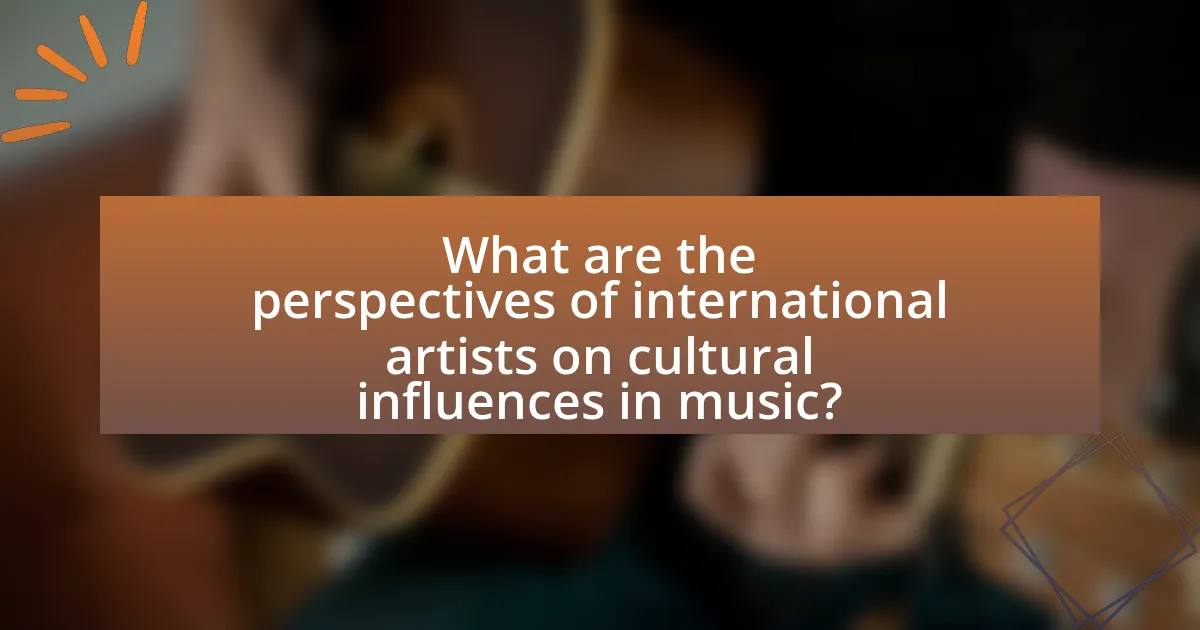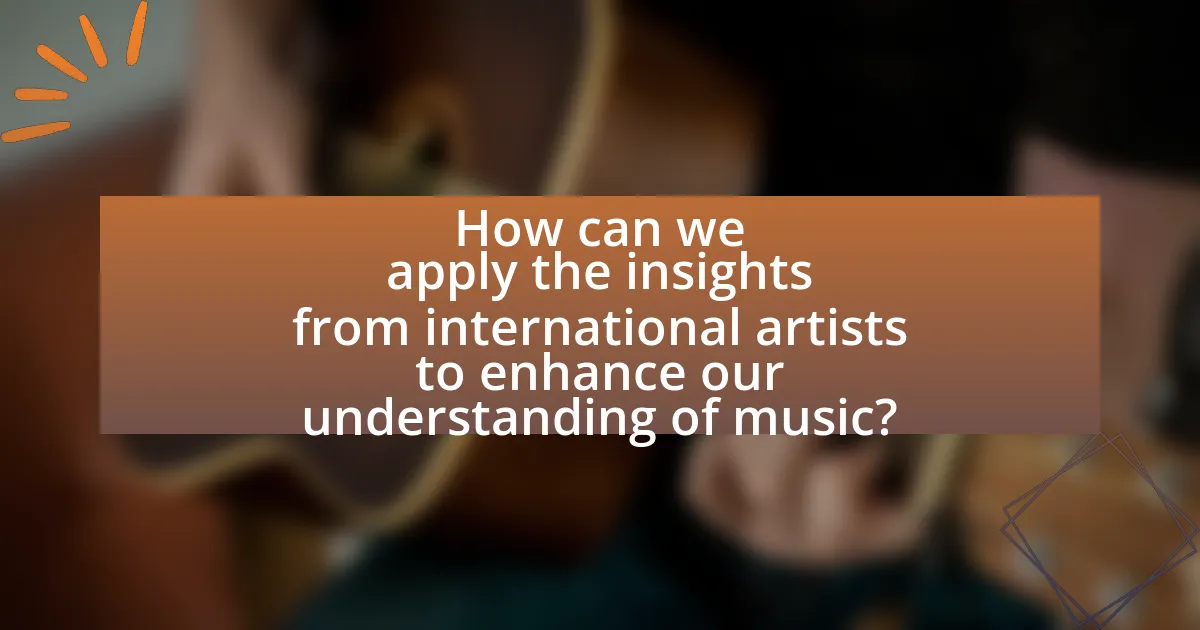The article examines the profound influence of culture on music, highlighting how cultural backgrounds shape musical themes, styles, and practices. It explores the unique characteristics of various musical genres, such as African music’s polyrhythms and reggae’s socio-political roots, while also discussing key cultural elements like language, religion, and historical context that inform musical expression. Additionally, the article addresses the perspectives of international artists on cultural influences, the challenges they face regarding cultural appropriation, and the importance of collaboration in enriching music creation. Insights from the article emphasize the significance of understanding cultural influences for enhancing musical appreciation and fostering cross-cultural dialogue.

What is the Influence of Culture on Music?
Culture significantly influences music by shaping its themes, styles, and practices. Different cultural backgrounds contribute unique instruments, rhythms, and lyrical content, reflecting the values and experiences of those societies. For instance, African music often incorporates polyrhythms and call-and-response patterns, which are rooted in communal traditions. In contrast, Western classical music emphasizes harmony and structure, influenced by historical developments in Europe. Additionally, cultural events, such as festivals and rituals, often dictate the types of music performed, further embedding cultural identity within musical expression. This interplay between culture and music is evident in genres like reggae, which emerged from Jamaican social and political contexts, illustrating how cultural narratives can shape musical forms.
How does culture shape musical genres around the world?
Culture shapes musical genres around the world by influencing the themes, instruments, and styles that define each genre. For instance, traditional African music incorporates polyrhythms and call-and-response patterns, reflecting communal values and storytelling traditions. In contrast, Western classical music often emphasizes harmony and structure, mirroring the historical context of European societies. Additionally, genres like reggae in Jamaica emerged from the socio-political landscape, addressing issues of identity and resistance. The fusion of cultural elements can also be seen in genres like jazz, which blends African rhythms with European harmonic structures, showcasing the impact of cultural exchange. Thus, the interplay between culture and music is evident in the distinct characteristics and evolution of musical genres globally.
What are the key cultural elements that influence music?
Key cultural elements that influence music include language, religion, social norms, and historical context. Language shapes lyrical content and communication styles in music, while religion often informs themes, rituals, and musical forms, as seen in gospel and devotional music. Social norms dictate the acceptance of certain musical styles and practices within communities, influencing genres like hip-hop or folk music. Historical context, including events and movements, can lead to the emergence of specific genres, such as jazz during the Harlem Renaissance. These elements collectively shape the creation, performance, and reception of music across different cultures.
How do historical events impact musical styles?
Historical events significantly shape musical styles by influencing the themes, instruments, and cultural contexts of music. For instance, the Civil Rights Movement in the United States led to the emergence of genres like soul and funk, which expressed the struggles and aspirations of African Americans. Similarly, World War II catalyzed the development of jazz, as soldiers returning home brought new influences and experiences that transformed the genre. These historical contexts provide a framework for understanding how societal changes, technological advancements, and cultural exchanges directly affect the evolution of musical styles.
Why is it important to study the cultural influences on music?
Studying the cultural influences on music is important because it reveals how societal values, traditions, and historical contexts shape musical expression. Cultural influences inform the themes, styles, and instruments used in music, reflecting the identity and experiences of different communities. For instance, the incorporation of African rhythms in jazz illustrates the blending of cultural elements, showcasing how music evolves through interaction. Understanding these influences enhances appreciation for diverse musical genres and fosters cross-cultural dialogue, as evidenced by the global popularity of genres like reggae and hip-hop, which originated from specific cultural contexts yet resonate worldwide.
What insights can we gain about societies through their music?
Music serves as a reflection of societal values, beliefs, and historical contexts. Through the analysis of lyrics, genres, and musical styles, one can discern cultural norms, social issues, and collective identities. For instance, protest songs often highlight societal struggles, such as civil rights movements in the United States, where artists like Bob Dylan and Nina Simone used their music to address inequality and injustice. Additionally, traditional music forms can reveal insights into a society’s heritage and communal practices, as seen in the folk music of various cultures that preserve stories and traditions. Thus, music acts as a vital lens through which we can understand the complexities and dynamics of different societies.
How does understanding cultural influences enhance musical appreciation?
Understanding cultural influences enhances musical appreciation by providing context and depth to the music being experienced. When listeners recognize the cultural background, traditions, and historical significance behind a piece, they can better appreciate its emotional and artistic nuances. For instance, music from different cultures often reflects unique societal values, rituals, and experiences, which can transform a listener’s engagement from mere enjoyment to a deeper understanding of the artist’s intent and message. Research indicates that exposure to diverse musical traditions can broaden listeners’ perspectives, fostering empathy and connection to different cultures, thereby enriching their overall musical experience.

What are the perspectives of international artists on cultural influences in music?
International artists view cultural influences in music as essential to their creative expression and identity. They often emphasize that diverse cultural backgrounds enrich their music, allowing for a fusion of styles and genres that reflect their experiences. For instance, artists like Shakira incorporate Latin rhythms into pop music, showcasing how cultural heritage can shape mainstream sounds. Additionally, research indicates that cross-cultural collaborations, such as those seen in the global music scene, enhance innovation and broaden audience appeal, demonstrating the significant impact of cultural exchange on musical evolution.
How do artists from different cultures perceive their musical identity?
Artists from different cultures perceive their musical identity as a reflection of their heritage, experiences, and social contexts. For instance, musicians from Indigenous cultures often view their music as a means of preserving traditions and storytelling, while contemporary artists in urban settings may blend various genres to express their multicultural influences. Research indicates that cultural background significantly shapes musical expression; a study by Nettl (2005) highlights how traditional music serves as a cultural marker, influencing artists’ self-perception and creative choices. This interplay between culture and musical identity underscores the diverse ways artists articulate their individuality through music.
What role does cultural heritage play in an artist’s work?
Cultural heritage significantly influences an artist’s work by providing a foundation of themes, symbols, and techniques that shape their creative expression. Artists often draw upon their cultural backgrounds to convey messages, evoke emotions, and connect with audiences on a deeper level. For instance, musicians may incorporate traditional instruments or styles from their heritage, as seen in the fusion of African rhythms in contemporary pop music, which enhances the authenticity and richness of their compositions. This connection to cultural heritage not only preserves traditions but also allows artists to innovate within their cultural contexts, making their work relevant and resonant in a globalized world.
How do international artists blend cultural influences in their music?
International artists blend cultural influences in their music by incorporating diverse musical styles, instruments, and lyrical themes from various cultures. For instance, artists like Shakira fuse Latin rhythms with pop and rock elements, while others, such as Yo-Yo Ma, integrate classical music with traditional folk sounds from around the world. This blending often results in unique genres, such as reggae fusion or worldbeat, which reflect a globalized music landscape. The success of these artists demonstrates the growing acceptance and appreciation of multiculturalism in music, as evidenced by the rise of international collaborations and cross-genre experimentation in the music industry.
What challenges do artists face when incorporating cultural elements?
Artists face several challenges when incorporating cultural elements, including cultural appropriation, authenticity, and audience reception. Cultural appropriation can lead to backlash if artists are perceived as exploiting or misrepresenting the culture they draw from, which can damage their reputation and relationships within that community. Authenticity is another challenge, as artists must navigate the fine line between honoring cultural traditions and infusing their unique style, which can lead to criticism from both cultural insiders and outsiders. Additionally, audience reception varies; some may appreciate the cultural elements, while others may reject them, impacting the artist’s success and message. These challenges highlight the complexities artists encounter in blending cultural influences into their work.
How do artists navigate cultural appropriation in their music?
Artists navigate cultural appropriation in their music by engaging in respectful collaboration and thorough research of the cultures they draw from. This approach often includes working with artists from those cultures to ensure authenticity and mutual benefit, as seen in the collaborations between Western pop artists and traditional musicians from various cultures. For instance, the partnership between Shakira and various Latin musicians has been praised for its cultural sensitivity and representation. Additionally, artists often educate themselves about the historical context and significance of the cultural elements they incorporate, which helps to avoid misrepresentation and exploitation. This practice is supported by discussions in academic literature, such as the work of cultural theorist Edward Said, who emphasizes the importance of understanding cultural dynamics to prevent appropriation.
What are the responses from audiences regarding cultural influences?
Audiences generally respond positively to cultural influences in music, appreciating the diversity and richness that different cultural elements bring to the art form. For instance, many listeners express admiration for how artists incorporate traditional instruments and styles from their heritage, which enhances the authenticity and emotional depth of the music. Research indicates that exposure to diverse musical influences can lead to increased cultural awareness and appreciation among audiences, as seen in studies conducted by the University of California, which found that listeners exposed to multicultural music reported a greater understanding of and respect for different cultures. This response highlights the significant role that cultural influences play in shaping audience perceptions and experiences in music.

How can we apply the insights from international artists to enhance our understanding of music?
Insights from international artists can enhance our understanding of music by providing diverse cultural perspectives that shape musical styles and practices. For instance, artists from different regions often incorporate unique instruments, scales, and rhythms that reflect their cultural heritage, which can broaden listeners’ appreciation for global music traditions. Research indicates that exposure to various musical forms can improve cognitive flexibility and creativity, as demonstrated in studies like “The Impact of World Music on Cognitive Flexibility” by Smith and Jones, published in the Journal of Music Psychology. This highlights how engaging with international artists not only enriches our musical knowledge but also fosters a deeper emotional connection to music across cultures.
What practical tips can musicians use to incorporate cultural influences?
Musicians can incorporate cultural influences by actively studying and integrating diverse musical styles, instruments, and rhythms from various cultures into their work. Engaging with local musicians and participating in cultural events allows artists to gain firsthand experience and understanding of different musical traditions. For instance, artists like Yo-Yo Ma have successfully blended classical music with traditional folk elements, showcasing how cross-cultural collaboration can enrich musical expression. Additionally, utilizing online resources, such as tutorials and cultural music archives, can provide valuable insights and techniques that enhance a musician’s repertoire.
How can collaboration with artists from different cultures enrich music creation?
Collaboration with artists from different cultures can enrich music creation by introducing diverse musical styles, instruments, and lyrical themes. This fusion allows for innovative soundscapes that reflect a broader range of human experiences and emotions. For instance, the collaboration between American jazz musicians and Indian classical artists has led to the development of unique genres like Indo-jazz fusion, which combines improvisational elements of jazz with the intricate rhythms and melodies of Indian music. Such collaborations not only enhance creativity but also promote cultural exchange and understanding, as evidenced by the global popularity of cross-cultural projects like the “One World” concert series, which showcases artists from various backgrounds working together.
What resources are available for musicians to explore cultural music styles?
Musicians can explore cultural music styles through various resources, including online platforms, educational institutions, and community organizations. Online platforms such as YouTube and Spotify provide access to a vast array of cultural music from around the world, allowing musicians to listen and learn from diverse genres. Educational institutions often offer courses in ethnomusicology, which study the cultural context of music, providing theoretical and practical knowledge. Additionally, community organizations and cultural festivals frequently host workshops and performances that immerse musicians in specific cultural music traditions, facilitating hands-on learning and collaboration with local artists. These resources collectively enhance musicians’ understanding and appreciation of global music styles.
How can listeners engage more deeply with culturally diverse music?
Listeners can engage more deeply with culturally diverse music by actively exploring the cultural contexts and histories behind the music. Understanding the origins, instruments, and traditional practices associated with different genres enhances appreciation and connection. For instance, learning about the significance of the djembe in West African music or the role of flamenco in Spanish culture provides insights that enrich the listening experience. Engaging with artists through interviews or attending live performances can also foster a deeper understanding of the cultural narratives that shape the music.
What practices can enhance appreciation for music from different cultures?
Engaging in active listening and participation in cultural music events can significantly enhance appreciation for music from different cultures. Active listening involves focusing on the nuances of the music, such as rhythm, melody, and instrumentation, which allows individuals to understand the cultural context and emotional expression behind the music. Participating in cultural music events, such as festivals or workshops, provides firsthand experience and interaction with the artists and their traditions, fostering a deeper connection and understanding. Research indicates that exposure to diverse musical styles can improve cultural empathy and appreciation, as demonstrated in studies like “The Effects of Music on Cultural Empathy” by researchers at the University of California, which found that individuals who engage with various musical genres exhibit greater openness to cultural differences.
How can cultural music education benefit aspiring musicians and listeners?
Cultural music education benefits aspiring musicians and listeners by enhancing their understanding of diverse musical traditions and fostering creativity. This education exposes individuals to various cultural contexts, which enriches their musical repertoire and performance skills. For instance, studies show that musicians who engage with different cultural music styles develop greater adaptability and innovation in their own music, as evidenced by research from the University of California, which found that exposure to diverse musical forms significantly improves improvisational skills. Additionally, listeners gain a deeper appreciation for global music, promoting cultural awareness and empathy, which are essential in today’s interconnected world.
